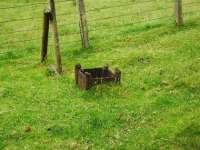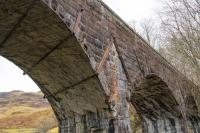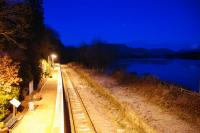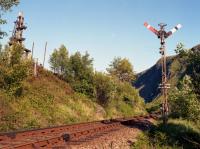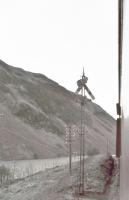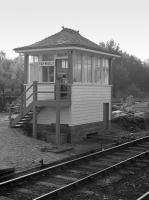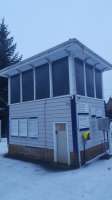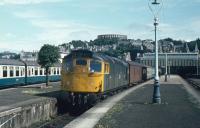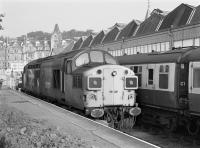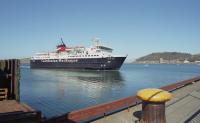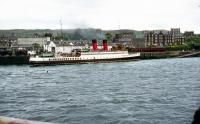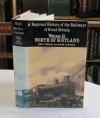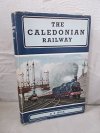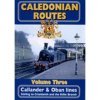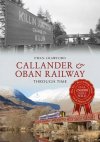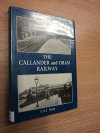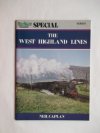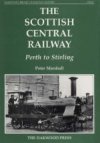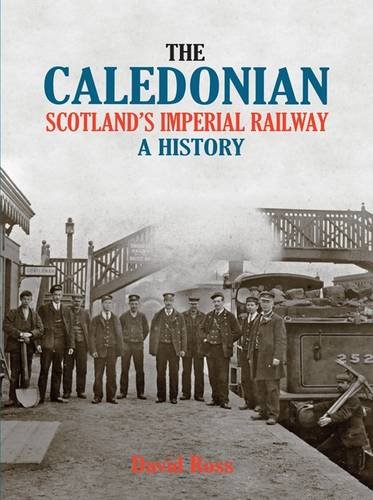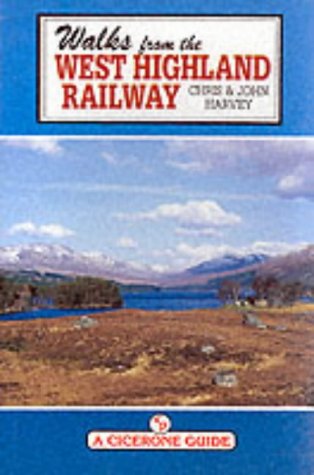Callander and Oban Railway
Introduction
This line is partly open, the remaining portion runs between the West Highland Railway at Crianlarich and Oban. Trains from Glasgow Queen Street High Level run to Crianlarich where they split into Oban and Fort William portions.
The line opened between Callander and Glenoglehead Crossing (then called Killin station) until sufficient funds were found to extend it to Tyndrum. At Tyndrum there was a short continuation to lead mines. The next extension was to Dalmally. Finally enough money was raised to take the line on to Oban.
A branch took the company on to Ballachulish and other lines opened to Loch Tay and Comrie.
The line is signalled by RETB and controlled from Banavie, near Fort William. The line is notable for the Pass of Brander Stone Signals, an unusual set of semaphore signals which protect the line from rockfalls.
The line was a protege of the Caledonian Railway.
The remaining part of the line is supported by the Friends of the West Highland Lines who were formed in 1983 and have promoted the line ever since. The society publishes the excellent West Highland News Plus.
With the loss of the majority of the station buildings, the eastern half of the line and the Oban trainshed the line has lost much of its original character. However, the scenery remains spectacular and Oban Pier retains its atmosphere as ferries, fishing boats, tour boats, bikes, cars, caravans and trucks for the Western Isles and foot passengers and tourists abound.
Much of the closed eastern half and the Ballachulish branch remain as footpaths.
Why built
This railway was built to connect the lowlands of Scotland, and the Central Belt, to the West Coast and its fisheries. Oban was already a port and this was to be enhanced by the arrival of the railway.
Architecture
Of the open stations only Dalmally retains its station building, built in stone and with a glazed canopy. A signal box remains at Taynuilt. The distinctive timber station buildings of the line are gone.
Other highlights on the open line survive such as the Orchy Viaduct and the Pass of Brander Stone Signals.
Dates
| / /1850 | Scottish Central Railway New locomotive shed, Stirling Shed [CR], opened; stone built four road shed replacing timber shed. The shed was originally single ended with the tracks running to the north. The shed was used for freight locomotives and, later, the Callander and Oban Railway. |
| 22/06/1864 | Callander and Oban Railway First meeting of the Callander and Oban Railway Committee. |
| 05/07/1865 | Callander and Oban Railway Act receives Royal assent. |
| 01/09/1865 | Callander and Oban Railway Appointment of John Anderson as the company secretary. |
| 27/06/1866 | Callander and Oban Railway Contract for constructing the Callander to Glenoglehead section given to J McKay. |
| /08/1868 | Callander and Oban Railway With the line partly complete coal traffic begins. Coal begins to be worked by the contractor from Callander Callander and Oban Junction to Lochearnhead [1st]. |
| / /1869 | Callander and Oban Railway Terms of the working of the line by the Caledonian Railway agreed. |
| / /1870 | Callander and Oban Railway Authorisation of Tyndrum [C&O] to Oban abandoned. |
| 01/06/1870 | Callander and Oban Railway Callander and Oban Junction through Callander Dreadnought to Killin [1st] (Glenoglehead) opened, operated by the Caledonian Railway. Stations opened Callander Dreadnought, Strathyre, Lochearnhead [1st], Killin [1st]. |
| 01/08/1870 | Callander and Oban Railway North British Railway allowed access to Callander Dreadnought from Callander and Oban Junction. The company had access as far as the junction by means of running powers and paid to extend beyond that to Callander Dreadnought. The NB considered a branch from west of the station to Loch Katrine in the Trossachs. |
| 01/08/1870 | Callander and Oban Railway Caledonian Railway allowed access to Callander Dreadnought from Callander and Oban Junction, paying the smaller company for access. |
| 21/06/1871 | Callander and Oban Railway Kingshouse Halt opened following petitioning from local people. |
| 01/08/1873 | Callander and Oban Railway Killin [1st] to Tyndrum [1st] opened. (At Tyndrum the new line crosses the course of the former waggonway between the lead mines and smelter.) |
| / /1874 | Callander and Oban Railway Tyndrum Goods Junction to Oban, Oban Goods line and branch to Oban Harbour, authorised. |
| /11/1876 | Callander and Oban Railway Special train run to Succoth Viaduct with invited guess to see Mrs Dinnie, the wife of the bridge contractor, fit the keystone. There was a temporary wooden platform for the occasion. |
| 01/04/1877 | Callander and Oban Railway Tyndrum Goods Junction to Dalmally opened for goods traffic. |
| 01/05/1877 | Callander and Oban Railway Tyndrum Goods Junction to Dalmally opened to passengers. Tyndrum [CandO] and Dalmally opened, Tyndrum [1st] becomes a goods depot. A single road stone shed, Dalmally Shed, opened to the south of Dalmally station with a 48ft turntable. |
| / /1878 | Callander and Oban Railway New approach to Oban Bay with a seawall and Oban Pier and Oban station authorised. The planned branch to Oban Harbour is abandoned. |
| 12/06/1880 | Callander and Oban Railway Line opened from Dalmally to Oban for goods. |
| 30/06/1880 | Callander and Oban Railway Opening ceremony for whole Callander Dreadnought to Oban line. Banquet in Oban station. |
| 01/07/1880 | Callander and Oban Railway Dalmally Shed ceases to be a key shed when the line to Oban opens completely. |
| 01/07/1880 | Callander and Oban Railway Line opened from Dalmally to Oban for passengers. The whole line is now open to passengers. Additionally Lochavullin Goods (Oban High Level Goods) opens. |
| / /1881 | Callander and Oban Railway Oban Goods Junction to Oban doubled. |
| 20/06/1881 | Callander and Oban Railway Steamers start running from Ach-na-Cloich up Loch Etive. |
| / /1882 | Callander and Oban Railway Glenlochy Crossing opened. |
| 27/06/1882 | Callander and Oban Railway Large fence built to detect boulders which roll onto the trackbed in the Pass of Brander authorised. Pass of Brander Stone Signals. |
| /11/1882 | Glasgow and North Western Railway Glasgow and North Western Railway proposed, the Bill presented to Parliament to seek approval. The route was to have been a 167 mile long railway from Glasgow to Inverness via Fort William. Supported by the North British Railway and opposed by the Highland Railway, Caledonian Railway (part owners of the Callander and Oban Railway), Caledonian Canal, David MacBrayne and some landowners. The Bill was rejected in 1883. It was not built (a less ambitious variation of it, the West Highland Railway with an Act in 1889, did open). |
| / /1883 | Callander and Oban Railway Bay platform for terminating trains added at the east end of Callander Dreadnought's westbound platform. A second bay, and sidings, were added at the west end of the same westbound platform. A pair of loops without platform access was laid around the north side of the station. |
| 19/06/1885 | Callander and Oban Railway Drishaig Junction installed for the branch to Ben Cruachan Quarry and the zig-zag lines. |
| 01/04/1886 | Callander and Oban Railway Killin [1st] station closed to public and becomes Glenoglehead crossing, having been replaced by Killin [2nd]. |
| 01/04/1886 | Killin Railway Killin Junction to Loch Tay opened; stations at Killin Junction (on the Callander and Oban Railway), Killin [2nd] and Loch Tay. |
| 13/09/1886 | Callander and Oban Railway Falkirk to Oban excursion train derails near the Succoth Viaduct. |
| 02/02/1889 | West Highland Railway A blizzard covers Rannoch Moor and the party have to work their way through deep drifting to reach Tyndrum [CandO] station on the Callander and Oban Railway. |
| 09/10/1890 | Callander and Oban Railway Temporary box and sidings opened during work to lower the line onto a slightly different alignment at Glencruitten Summit. |
| / /1891 | Callander and Oban Railway Siding opened near Crianlarich [C&O] for construction of the West Highland Railway. |
| 27/07/1893 | Callander and Oban Railway St Brides Crossing opened between Callander Dreadnought and Strathyre. |
| 29/07/1893 | Callander and Oban Railway Awe Crossing loop opened. |
| 20/12/1894 | Callander and Oban Railway Spur from Crianlarich station (West Highland Railway) to Crianlarich Junction [CandO] opened. New passing loop at Crianlarich Junction [CandO] allows removal of up platform and loop at Crianlarich [CandO] station. |
| / /1896 | Callander and Oban Railway Bay platform added to east end of Callander Dreadnought's eastbound platform, between the north side of the main eastbound line platform and the two loops north of the station. |
| 28/07/1896 | Callander and Oban Railway Siding and loading bank opened at Tyndrum [CandO] to west of station, on the north side of line. |
| 07/08/1896 | Ballachulish Branch (Callander and Oban Railway) Callander and Oban Railway (Ballachulish Extension) Act passed. (Alternative date 1/4/1896). |
| / /1897 | Callander and Oban Railway Expansion of Oban and Oban Station Pier authorised in connection with the opening of the Ballachulish Branch (Callander and Oban Railway). Alterations to sea wall authorised. |
| 20/12/1897 | West Highland Railway Connection to Callander and Oban Railway at Crianlarich, from Crianlarich Junction to Crianlarich Junction [CandO]. |
| / /1900 | Callander and Oban Railway Extension of time granted for expansion works at Oban. |
| / /1901 | Ballachulish Branch (Callander and Oban Railway) Callander and Oban Railway granted more time to complete line. |
| / /1901 | Callander and Oban Railway Electric lighting at Oban authorised. |
| / /1902 | Callander and Oban Railway Caledonian Railway authorised to take over and run the new exchange station on the Callander and Oban Railway, Balquhidder [2nd] (replacing Balquhidder [1st], formerly Lochearnhead [1st]). |
| / /1902 | Lochearnhead, St Fillans and Comrie Railway Authorisation for diversion by at Lochearnhead [1st], by the Callander and Oban Railway, in connection with the opening of the Lochearnhead, St Fillans and Comrie Railway. |
| 02/11/1902 | Callander and Oban Railway Dunblane, Doune and Callander Railway Callander Dreadnought to Callander and Oban Junction doubled. Callander and Oban Junction signal box replaced and junction remodelled with headshunt and loop around box. |
| 04/03/1903 | Callander and Oban Railway Oban station enlargement authorised. |
| 12/08/1903 | Callander and Oban Railway Glencruitten Crossing opened at Glencruitten Summit. Opened in anticipation of the opening of the Ballachulish Branch (Callander and Oban Railway). |
| 01/07/1904 | Callander and Oban Railway Lochearnhead [1st] renamed Balquhidder [1st]. |
| 18/07/1904 | Lochearnhead, St Fillans and Comrie Railway Opened to goods and minerals from St Fillans to new Balquhidder [2nd] station on the Callander and Oban Railway. |
| 01/05/1905 | Lochearnhead, St Fillans and Comrie Railway Line extended from Lochearnhead [2nd] to the new Balquhidder [2nd] station on the Callander and Oban Railway. (Balquhidder [1st] closed.) |
| 07/07/1905 | Callander and Oban Railway Introduction of C. & O. Hotel Express. |
| / /1906 | Callander and Oban Railway Water columns installed on the platforms at Balquhidder [2nd]. |
| 31/07/1907 | Callander and Oban Railway Retirement of John Anderson. |
| /07/1908 | Callander and Oban Railway Falls of Cruachan Halt appears in timetable. |
| 01/07/1909 | Callander and Oban Railway Charabanc operates over Connel Ferry Bridge; Benderloch and North Connel to Connel Ferry. |
| 02/06/1913 | Callander and Oban Railway Motor service introduced between Loch Awe and Inveraray. |
| / /1914 | Ballachulish Branch (Callander and Oban Railway) Callander and Oban Railway company and council finally come to an agreement to allow cars, on payment of a toll, to cross the Connel Ferry Bridge when trains are not running. |
| 22/06/1914 | Callander and Oban Railway Connel Ferry Bridge altered for road vehicles and pedestrians. |
| 03/08/1914 | Callander and Oban Railway Maid of Morven observation car introduced. |
| /02/1915 | Callander and Oban Railway Maid of Morven observation car withdrawn. |
| / /1916 | Callander and Oban Railway Ach-na-Cloich timber siding added. |
| /05/1916 | Callander and Oban Railway Ben Cruachan Quarry branch closed and Drishaig Junction taken out. |
| /03/1919 | Callander and Oban Railway Maid of Morven observation car re-introduced. |
| / /1923 | Callander and Oban Railway Crunachy Siding opened. |
| 01/01/1923 | Dundee and Newtyle Railway Arbroath and Forfar Railway Glasgow and Paisley Joint Railway Caledonian Railway Glasgow and South Western Railway Callander and Oban Railway Glasgow and Kilmarnock Joint Railway Highland Railway Cathcart District Railway Killin Railway Lanarkshire and Ayrshire Railway Portpatrick and Wigtownshire Joint Committee Brechin and Edzell District Railway Dornoch Light Railway Wick and Lybster Light Railway Grouped into London, Midland and Scottish Railway. |
| / /1930 | Callander and Oban Railway Dalmally Shed closed. |
| / /1938 | Callander and Oban Railway Dalmally Shed still standing, but demolished at unknown date afterwards. |
| 10/04/1938 | Callander and Oban Railway Dunblane, Doune and Callander Railway Callander and Oban Junction closed. The double track line to Callander Dreadnought becomes two single track lines with the former westbound line becoming access from Callander Dreadnought to Callander [1st] (goods) via the headshunt at the site of Callander and Oban Junction. |
| /05/1940 | Callander and Oban Railway Wartime sidings laid out at St Brides Crossing. |
| 07/07/1940 | Callander and Oban Railway Achaleven Sidings opened at Connel Ferry for the Admiralty. |
| / /1946 | Callander and Oban Railway Crunachy Siding closed. |
| /06/1948 | Callander and Oban Railway Achaleven Sidings at Connel Ferry closed. |
| / /1950 | Callander and Oban Railway Former Dalmally Shed siding removed? |
| /03/1950 | Callander and Oban Railway Wartime sidings at St Brides Crossing taken out. |
| / /1951 | Callander and Oban Railway Glenoglehead sidings lifted. |
| 23/09/1951 | Callander and Oban Railway St Brides Crossing loop closed. |
| 03/10/1951 | Callander and Oban Railway Loading bank and siding at west end of Tyndrum Lower removed. |
| / /1953 | Callander and Oban Railway Tyndrum [CandO] becomes Tyndrum Lower to make the distinction from Tyndrum [WHR] (renamed Tyndrum Upper) station. |
| / /1959 | Callander and Oban Railway Concrete silo erected at Taynuilt station goods yard for the Cruachan hydro-electric scheme construction. |
| 12/05/1962 | Callander and Oban Railway Caledonian Railway No 123 and North British Railway No 256 visit Oban. |
| / /1964 | Callander and Oban Railway Ach-na-Cloich siding removed. |
| 17/09/1964 | Callander and Oban Railway Closed to goods from Callander Dreadnought (excluded) to Luib (excluded). Goods traffic is re-routed via Crianlarich Upper. |
| / /1965 | Callander and Oban Railway Dalmally closed to goods. Headshunt retained as siding. |
| 27/09/1965 | Callander and Oban Railway Landslide in Glen Ogle blocks railway; line closed between Callander and Crianlarich. (Glen Ogle Rockfall). |
| 27/09/1965 | Killin Railway Killin [2nd] to Killin Junction closed to passengers and completely. Due to the rockfall in Glen Ogle in the early hours the Callander and Oban Railway was closed and the branch service had no trains to meet. The final train from Killin [2nd] was hauled by 80093 with three carriages and 13 wagons - although this was too heavy and the wagons had to be left temporarily while the carriages were taken to Killin Junction before the locomotive returned for the wagons. Once re-combined the train, unusually, ran through to Crianlarich and then south to Glasgow. Loch Tay Shed facilities closed. |
| 28/09/1965 | Callander and Oban Railway Killin Railway Due to the extent of the Glen Ogle Rockfall, Crianlarich Lower (excluded) to Callander (excluded) closed to all traffic. |
| 01/11/1965 | Callander and Oban Railway Crianlarich Lower to Callander Dreadnought officially closed to passengers (the Glen Ogle Rockfall closed the line on 28/09/65 and beyond Callander there was a replacement bus service until the end, trains continuing on the portion east of Callander). Following withdrawal of the bus service no public passenger service at all (bus or train) was available between Crianlarich and Killin [2nd]. Official closure of Callander Dreadnought, Strathyre, Kingshouse Platform, Lochearnhead, Killin Junction, Luib, Crianlarich Lower and Killin [2nd]. Crianlarich Lower to Luib remains open to goods. |
| 01/11/1965 | Callander and Oban Railway Loch Awe, Ach-na-Cloich closed. |
| / /1966 | Callander and Oban Railway Tyndrum [1st] (the former terminus in use as a goods yard) to Tyndrum Goods Junction (a headshunt by this date) to Tyndrum Lower closed. |
| / /1966 | Callander and Oban Railway Dismantling between Crianlarich Lower and Callander Dreadnought begins at Glen Ogle Rockfall. |
| 16/02/1966 | Callander and Oban Railway Crianlarich Lower (excluded) to Luib closed to goods. |
| 07/05/1966 | Callander and Oban Railway Glencruitten Crossing closed. |
| 10/07/1966 | Callander and Oban Railway Glenlochy Crossing closed. |
| 02/10/1966 | Callander and Oban Railway Loch Awe signal box closed and loop closed. |
| 02/10/1966 | Callander and Oban Railway Awe Crossing loop closed. |
| / /1967 | Callander and Oban Railway Dismantling reaches the west end of Callander Dreadnought early in the year. It does not continue further east at this time. |
| 08/01/1967 | Callander and Oban Railway Connel Ferry east and west signal boxes closed. Main line loops and goods bypass line taken out. The remaining line, used for both directions, is the former branch platform line (originally the eastbound line before the branch opened). |
| 26/02/1967 | Callander and Oban Railway West Highland Railway Crianlarich West and Crianlarich East signal boxes at Crianlarich Lower Junction closed, replaced by a ground frame. |
| / /1968 | Callander and Oban Railway Connel Ferry oil siding and loop opened east of the station. |
| / /1969 | Callander and Oban Railway Dismantling continues eastwards from Callander Dreadnought. |
| / /1969 | Callander and Oban Railway Concrete silo removed from Taynuilt station. (Approximate date.) |
| 04/05/1969 | Callander and Oban Railway Oban to Oban Goods Junction becomes two single track lines on closure of Oban Goods Junction signal box. Oban Goods is now approached from Oban on the eastern of the two tracks with a headshunt at the former Oban Goods Junction. |
| 12/10/1969 | Callander and Oban Railway Tyndrum Lower signal box closed and westbound loop taken out. |
| 02/08/1981 | West Highland Railway
Callander and Oban Railway A Class 55 'Deltic' visits Oban for the first time (55021 'Argyll and Sutherland Highlander') on a 'Merrymaker' excursion from Edinburgh Waverley to Oban. |
| 23/08/1981 | West Highland Railway
Callander and Oban Railway Second visit of 'Deltic' 55021 to Oban on a 'Merrymaker' excursion from Edinburgh Waverley. |
| 01/05/1985 | Callander and Oban Railway Loch Awe re-opened to passengers. |
| 23/01/1989 | Callander and Oban Railway Sprinters introduced on line. |
| /03/1990 | Callander and Oban Railway Taynuilt signal box relocated from the west to the east end of the station. |
| 05/04/1997 | Callander and Oban Railway Railway blocked by a landslip at Loch Awe which derailed a Sprinter. |
| /08/2000 | Callander and Oban Railway Approval to convert Taynuilt's B listed station building into a Heritage Centre by Argyll Transport Trust. |
| /09/2000 | Callander and Oban Railway Repairs to Taynuilt station building, at a cost of £130,000m approved. Approval to convert the building into a Heritage Centre is withdrawn by Railtrack. |
| 17/03/2003 | Callander and Oban Railway Temporarily closed by bridge strike, no damage. |
| 22/05/2006 | Callander and Oban Railway New timber terminal at Crianlarich Lower proposed by Argyll Timber Transport Group, English, Welsh and Scottish Railway, Network Rail and Kronospan, taking 6,500 trucks off the road annually. (Not opened.) |
| 07/03/2020 | West Highland Railway
Callander and Oban Railway Caledonian Sleeper temporarily diverted to Oban due to flooding at Monessie Gorge. |
Route described
The railway ran west from Callander before turning north and climbing in the Pass of Leny and then running on the west side of Loch Lubnaig to reach Strathyre. From Strathyre it continued past the Kingshouse Inn to reach Balquhidder.
From Balquhidder a steady and steep climb was needed up Glen Ogle to reach the original terminus at Glenoglehead (optimistically named Killin, some three miles away).
Beyond Glenoglehead the line dropped through Killin Junction, for the branch to Killin, and the line turned west to run through Glen Dochart to reach Luib and Crianlarich. Beyond Crianlarich the line climbs to reach Tyndrum, the second terminus.
After Tyndrum a summit is crossed and Glen Lochy followed to Dalmally, the third terminus.
From Dalmally the line passes the northern end of Loch Awe, with its striking Kilchurn Castle, and the hydro power station within the southern slopes of Ben Cruachan to reach the steep sided Pass of Brander. At Taynuilt the sea is reached, Loch Etive, and the line follows the southern short of the loch to reach Connel Ferry with its large former railway bridge crossing the Falls of Lora. The line turns inland passing through Glen Cruitten to swing round and approach Oban from the south. A steep drop to the natural harbour twists and turns giving sight of the sea ahead. The line finishes on the ferry pier.
Portions of line and locations
This line is divided into a number of portions.
Callander to Killin (Glenoglehead)
Single track passenger and goods line from Callander and Oban Junction to Glenoglehead. This opened in 1870, connecting coaches continuing the journey west until the line was extended. Closed following the Glen Ogle Rockfall in 1965.
This was the junction between the Dunblane, Doune and Callander Railway and the Callander and Oban Railway which extended it to Oban. Callander [1st] was left on a short branch being replaced by Callander (Dreadnought) further west. The original signal box was to the north of the junction at the point of division of the lines.
...
See also
Dunblane, Doune and Callander Railway
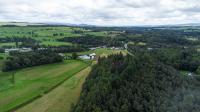
Ewan Crawford 24/08/2023
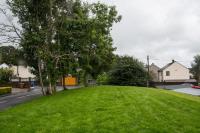
Ewan Crawford 24/08/2023
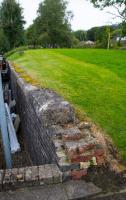
Ewan Crawford 24/08/2023
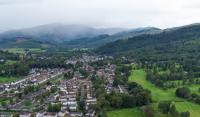
Ewan Crawford 24/08/2023
This ticket platform was east of Callander (Dreadnought) station, a little west of the start of the double track section at Callander and Oban Junction. It opened when the line between the junction and Dreadnought station was doubled. It was a long timber single platform on the south side of line (serving westbound trains arriving in Callander) and was built in timber with station signs ...
More details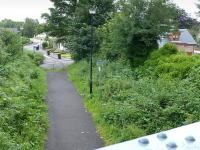
Bill Roberton 21/07/2015
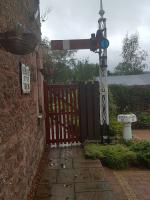
John Yellowlees 28/08/2017
The original 1870 station here had two platforms, a loop and a timber building. It replaced the original Callander [1st] terminus in the east of the town. This station was on the northern edge of the town.
...
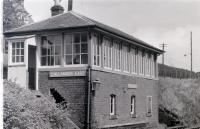
...
Colin Miller /10/1968
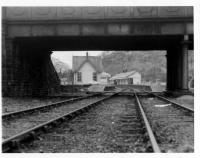
...
Colin Miller /10/1968
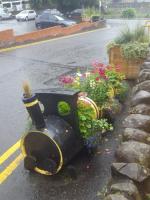
John Yellowlees 28/08/2017
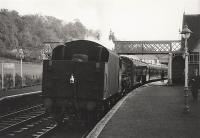
Brian Haslehust 30/10/
This bowstring girder viaduct was west of Callander (Dreadnought), the line crossing from the north bank to the south bank of the Garbh Uisge. The east end had a single plate girder approach.
...
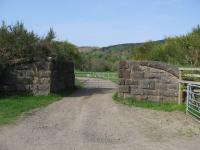
Michael Gibb 12/05/2008
This bowstring viaduct crossed over the Garbh Uisge in the Pass of Leny. For an Oban bound (westbound) train it crossed from the south to the north bank. The location was alongside the Falls of Leny. The viaduct was completed in 1867 by John Mackay.
...
This bowstring viaduct crossed over the Garbh Uisge in the Pass of Leny. For an Oban bound (westbound) train it crossed from the east to the west bank. The viaduct was completed in 1867 by John Mackay.
...
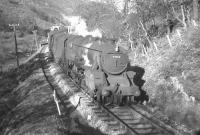
Frank Spaven Collection (Courtesy David Spaven) //1957
This was a passing loop, added in 1893 due to the increase in traffic. Little remains to be seen of the loop, the line itself is now a dirt road, except a bridge over a stream which clearly carried two tracks. John Anderson's proposal to open a public station here was rejected by the landowner.
...
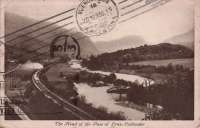
Ewan Crawford Collection //
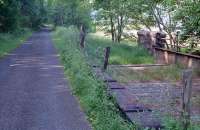
Ewan Crawford //1988
This platform was for the use of railway staff and their families. It was a single platform built in timber alongside Rock Cottage. The platform was on the west side of the line.
...
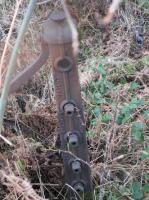
Gordon Steel 01/01/2017
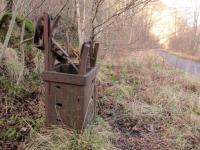
Gordon Steel 01/01/2017
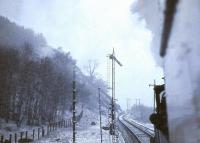
John Robin 12/04/1963
Early in the history of the Callander and Oban Railway trains could halt at the north end of Loch Lubnaig, by Laggan farm house, for fishermen. It was a request halt. There were probably no facilities.
...
This single track girder viaduct was to the south Strathyre station, crossing the River Balvag a little north of Loch Lubnaig.
...
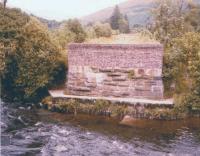
Ken Strachan /05/1974
This was a two platform station with a loop. It was originally a single platform station with a loop, possibly the second platform was added not long after opening. The station was noted for the ornate stork fountain of Cruachan granite, the choice of the stationmaster as a reward for many years of service. After station closure this was moved to the garden of a house in the village.
...
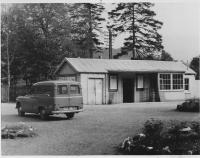
Ian Moir (courtesy of Alastair Moir) //
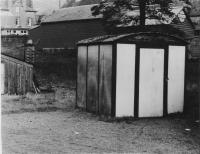
Ian Moir (courtesy of Alastair Moir) //
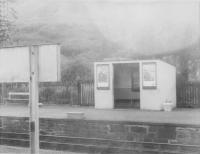
Ian Moir (courtesy of Alastair Moir) //
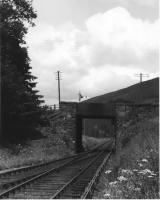
Ian Moir (courtesy of Alastair Moir) //
This was a request halt serving the nearby Kingshouse Hotel (just to the east) and road to Balquhidder Glen (to the west). The halt was built at the expense of the Kingshouse Hotel.
...
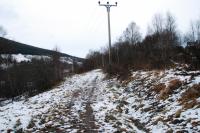
Ewan Crawford 07/02/2011
This was a three platform station where the Callander and Oban Railway met the branch east to St Fillans and Comrie. It replaced Balquhidder [1st].
...
See also
Lochearnhead, St Fillans and Comrie Railway
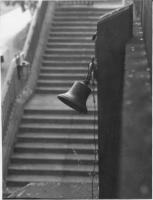
Ian Moir (courtesy of Alastair Moir) //
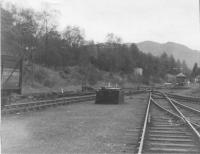
...
Ian Moir (courtesy of Alastair Moir) //
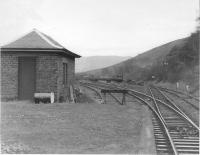
Ian Moir (courtesy of Alastair Moir) //
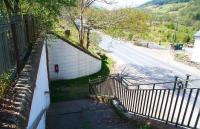
John Furnevel 14/05/2008
The original station here had a single platform with a timber building on a curve and a goods yard. The yard was to the north of the station, on the east side of the line.
...
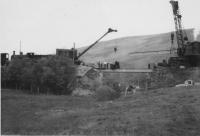
Ian Moir (courtesy of Alastair Moir) //
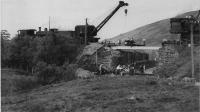
Ian Moir (courtesy of Alastair Moir) //
This single track three arch masonry viaduct carried the Callander and Oban Railway over the Kendrum Burn west of Edinchip House. The viaduct was completed in 1869 by John Mackay.
...
This 'B' listed cast iron accommodation footbridge with a wooden deck crosses the trackbed of the former Callander and Oban Railway just north of Edinchip Viaduct [C and O] and west of Edinchip House.
...
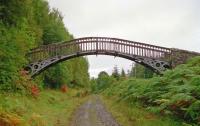
Ewan Crawford //1997
A landslide which had occurred in the very early hours of the morning in Glen Ogle was discovered on Monday the 27th of September 1965. The site was south of the Glen Ogle Viaduct on a section where rockfalls had occurred many times over the life of the railway. Trains that day were cancelled and redirected.
...
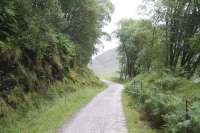
Ewan Crawford 19/08/2017
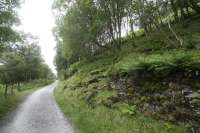
Ewan Crawford 19/08/2017
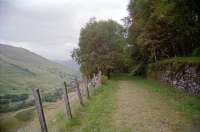
Ewan Crawford //1993
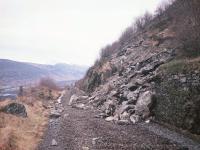
Frank Spaven Collection (Courtesy David Spaven) /12/1966
This is a disused 3 arch viaduct just south of (and could be considered an extension of) the Glen Ogle Viaduct. It was built in 1869 by John Mackay.
...
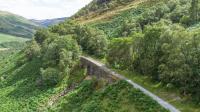
Ewan Crawford 04/08/2022
This is a disused 12 arch, 139 ft long overall, 44 ft high single track masonry viaduct in Glen Ogle running along the steep eastern hillside of Meall Reamhar and Scorrach Nuadh. It may just about have been possible for the line to have followed the hillside but would have involved very tight curves. The viaduct flies out from the hillside and then rejoins it. To the immediate south is a three ...
More details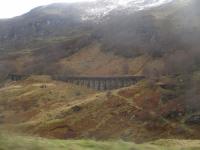
David Bosher 13/03/2019
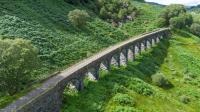
Ewan Crawford 04/08/2022
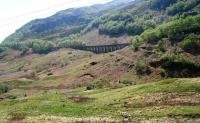
John Furnevel 14/05/2008

Ewan Crawford //1993
This was the original terminus of the Callander and Oban Railway and located somewhat far away (3.5 miles by road) from its namesake the town of Killin which required a connecting stagecoach. Stagecoaches also continued the journey to other points west such as Tyndrum and Oban.
...
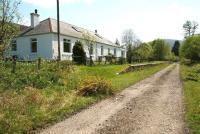
John Furnevel 14/05/2008
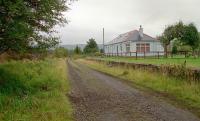
Ewan Crawford //1993
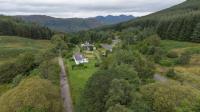
Ewan Crawford 17/08/2022
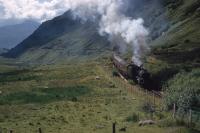
Roger Geach Collection //
Killin (Glenoglehead) to Tyndrum
Single track passenger and goods line from Glenoglehead to Tyndrum [1st]. This extension opened in 1873. Coaches extended the line west and even south, connecting with steamers. The eastern portion of this line closed in 1965 after the Glen Ogle Rockfall.
This was the original terminus of the Callander and Oban Railway and located somewhat far away (3.5 miles by road) from its namesake the town of Killin which required a connecting stagecoach. Stagecoaches also continued the journey to other points west such as Tyndrum and Oban.
...

John Furnevel 14/05/2008

Ewan Crawford //1993

Ewan Crawford 17/08/2022

Roger Geach Collection //
This was a three platform station with two platforms and a loop on the mainline, the up platform being an island the outer face of which chiefly served the Killin Railway and had a loop. Trains from the main line could access the branch platform line and loop from either end.
...
See also
Killin Railway
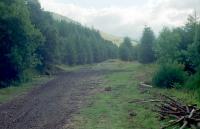
Ewan Crawford //1990
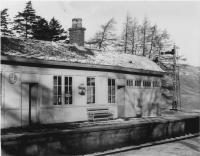
Ian Moir (courtesy of Alastair Moir) //
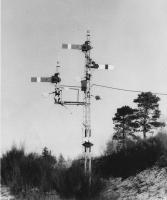
Ian Moir (courtesy of Alastair Moir) //
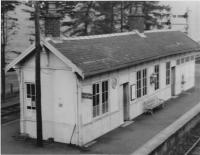
Ian Moir (courtesy of Alastair Moir) //
This is a disused masonry single track three arch viaduct just west of the former Killin Junction station crossing the Ardchyle Burn. The burn is very much lower than the surrounding ground making this a viaduct which is about the same height as it is in length.
...
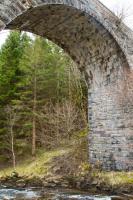
Ewan Crawford 20/04/2018
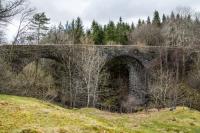
Ewan Crawford 20/04/2018
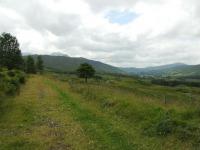
John Gray 23/07/2008
Also known as Glen Dochart Viaduct. This is an out of use single track three arch viaduct above Ledcharrie Farm which is to the north. The arches are reinforced with rails.
...
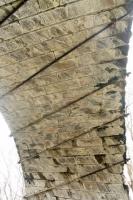
Ewan Crawford 20/04/2018
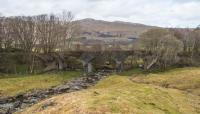
Ewan Crawford 20/04/2018
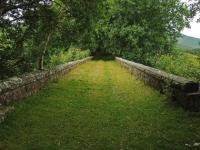
John Gray 23/07/2008
This was a single girder bridge above Edravinoch Farm, which is to the north. The former bridge is east of the former Luib station and west of Ledcharrie Viaduct.
...
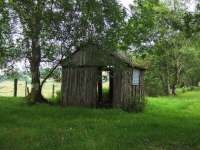
John Gray 23/07/2008
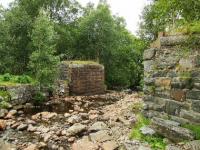
John Gray 23/07/2008
This was a two platform station. The main station building was on the eastbound platform, the building being of the typical style of the extension of the Callander and Oban Railway from Glenoglehead to Tyndrum [1st].
...
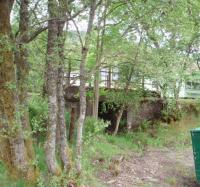
Mark Bartlett 30/05/2008
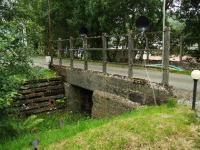
John Gray 23/07/2008
This was a private platform at the east end of Loch Dochart, near Portnellan. The line ran along the south side of the loch. The platform was on the south side of the line next to the main road. This was a curling platform.
...
This was a two platform station. The station building on the down platform was a typical later Callander and Oban Railway timber building but with a canopy along the length of the building.
...
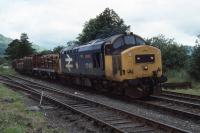
Roger Geach 20/07/1988
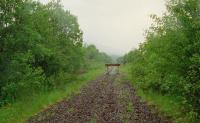
Ewan Crawford //1993
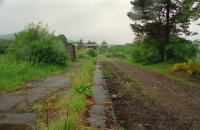
Ewan Crawford //1993

Doug Nicholls /01/1979
This junction remains open - just. A short somewhat grassy siding runs east.
...
See also
West Highland Railway
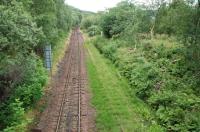
Ewan Crawford 29/07/2016
Crianlarich Junction [CandO] had an elaborate layout. The Callander and Oban Railway was doubled from west of the junction through the junction and further east, and the West Highland Railway was also double on approach to the junction.
...
This is level crossing between the Callander and Oban Railway and the access road to Inverhaggernie Farm, to the north. There is also an alternative directly to the west, a bridge over the road with limited clearance.
...
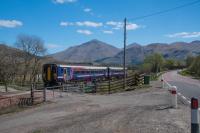
Ewan Crawford 05/05/2017
This three arch single track masonry viaduct crosses a minor burn. It was completed in 1872 by Easton Gibb.
...
This single track four arch viaduct, crossing the River Cononish, is between Crianlarich and Tyndrum Lower on the 1873 extension of the line from Killin [1st] to Tyndrum [1st].
...
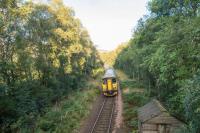
Ewan Crawford 16/09/2022

Ewan Crawford 16/09/2022

Ewan Crawford 05/03/2020
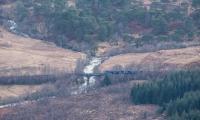
Ewan Crawford 05/03/2020
[This location name is somewhat artificial.] In 1877 the railway was extended west to Dalmally via a replacement Tyndrum station (now called Tyndrum Lower) and the original Tyndrum [1st] station became a goods yard and its signal box [1st box] closed. A new box was provided for the goods and passenger station [2nd box].
...
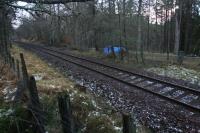
Ewan Crawford 19/12/2014
This was the terminus at Tyndrum of the extension of the Callander and Oban Railway west from Killin [1st].
...
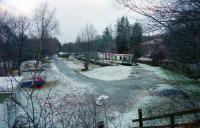
Ewan Crawford 26/12/1994
Tyndrum to Dalmally
Single track passenger and goods line from Tyndrum Goods Junction to Dalmally. This extension left the original Tyndrum station on a short branch, the original became a goods yard. The extension opened in 1877 and remains opened today.
[This location name is somewhat artificial.] In 1877 the railway was extended west to Dalmally via a replacement Tyndrum station (now called Tyndrum Lower) and the original Tyndrum [1st] station became a goods yard and its signal box [1st box] closed. A new box was provided for the goods and passenger station [2nd box].
...

Ewan Crawford 19/12/2014
This is a single platform station. The platform is on the north side of the running line. There is a car park at the west end and an occupational crossing. The station is south of Tyndrum, a small settlement at the west end of Strath Fillan.
...
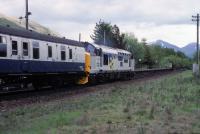
Roger Geach 19/05/1988
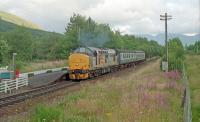
Ewan Crawford //1989

David Bosher 14/09/2022
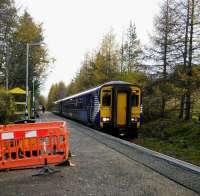
David Panton 01/11/2017
This summit, of 840 ft, is west of Tyndrum Lower on the Oban portion of the West Highland Line, formerly the Callander and Oban Railway.
...
This was a passing loop opened in 1882 to increase capacity of the line. It broke the single track section between Tyndrum Lower and Dalmally.
...
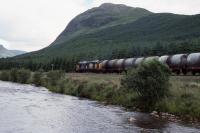
Roger Geach 20/07/1988
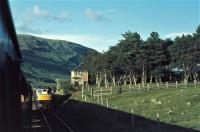
Brian Haslehust 27/08/1963

Ewan Crawford //1994
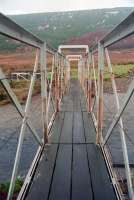
Ewan Crawford //1994
This is a single track six arch masonry viaduct crossing the Eas a' Ghaill (tributary to the River Lochy) and two estate roads. It was finished in November 1876 by Mrs Dinnie, wife of the builder, setting the keystone at a ceremony. Invited guests arrived by train, the location could be considered a very short lived station which predates Dalmally!
...
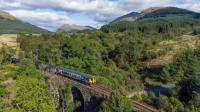
Ewan Crawford 16/09/2022
This is a two platform station. The main station building is on the eastbound (up) platform and is a red stone built two storey house with single storey offices. Gables are crow-stepped. The building is fitted with a full length glass canopy over the platform. The very fine building is due to the use of the station by the Duke of Argyll. The original timber station building burned down in ...
More details
Malcolm Chattwood 22/02/2023

David Bosher 14/09/2022
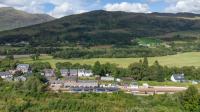
Ewan Crawford 24/08/2022
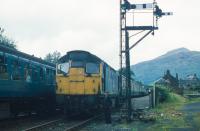
Brian Haslehust //1972
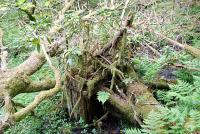
Ewan Crawford 10/06/2013

Ewan Crawford 10/06/2013
Dalmally to Oban
Single track passenger and goods line from Dalmally to Oban. This line opened in 1880 completing the main line of the Callander and Oban. Use of mass concrete was made and the line finished at a superb seaside station where connections to steamers could be made. A general goods yard was at a higher level in the town. The line remains open.
This is a two platform station. The main station building is on the eastbound (up) platform and is a red stone built two storey house with single storey offices. Gables are crow-stepped. The building is fitted with a full length glass canopy over the platform. The very fine building is due to the use of the station by the Duke of Argyll. The original timber station building burned down in ...
More details
Malcolm Chattwood 22/02/2023

David Bosher 14/09/2022

Ewan Crawford 24/08/2022

Brian Haslehust //1972
This level crossing provides road access to Kilchurn Castle. The road is a dirt road crossing the line just east of the Orchy Viaduct.
...
This is a seven single track span girder viaduct crossing the River Orchy. It is the longest viaduct on the Callander and Oban Railway route.
...
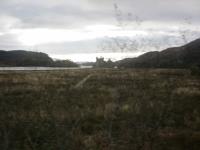
Gordon Steel 11/10/2016
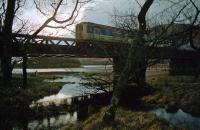
Ewan Crawford //1992
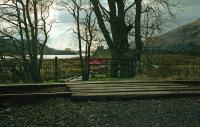
Ewan Crawford //1992
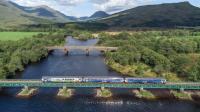
Ewan Crawford 24/08/2022
This was the junction for the Ben Cruachan Granite Quarries. The branch opened in 1885, five years after the main line. Trains from the branch ran on to Loch Awe to use the goods yard there as exchange sidings. The junction was released using the tablet for the Loch Awe to Dalmally section on which the junction lay. The junction closed in 1916.
...
See also
Ben Cruachan Quarries Branch (Callander and Oban Railway)
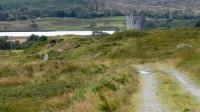
Ewan Crawford 24/08/2022
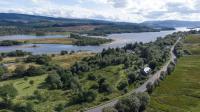
Ewan Crawford 24/08/2022
This is a single platform station alongside the north east shore of Loch Awe [Loch] with a footbridge over the line giving access to a pier, Loch Awe Pier. Only the former eastbound platform remains in use. High above is the Loch Awe Hotel which may be reached by a staircase up a cliff.
...
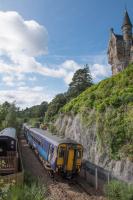
Ewan Crawford 16/09/2022

Robin McGregor 04/12/1970
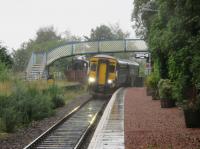
Alastair McLellan 03/09/2019
This is a small single platform near the Falls of Cruachan and Cruachan Hydro Electric Scheme visitor's centre.
...
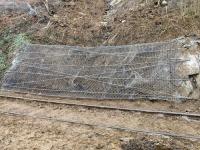
Network Rail 23/12/2022
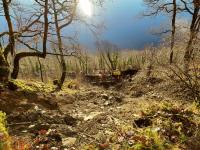
Ewan Crawford 22/12/2022
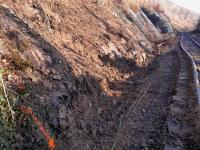
Network Rail 23/12/2022
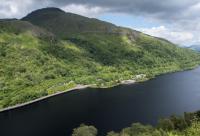
Ewan Crawford 21/06/2019
This is a single track three arch mass concrete viaduct with castellated parapets. It crosses at the Falls of Cruachan where the Allt Cruachan drops into Loch Awe, just west of Falls of Cruachan station.
...
This was a passing loop on the single track Callander and Oban Railway. The loop broke the section between Taynuilt, to the west, and Loch Awe to the east. Prior to the loop the single track length was 9.1 miles, broken into 4.5 miles to the west and 4.6 miles to the east).
...
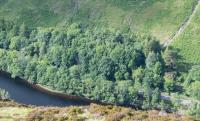
Ewan Crawford 21/06/2019
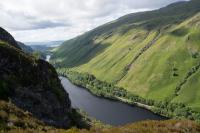
Ewan Crawford 21/06/2019
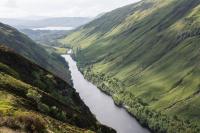
Ewan Crawford 21/06/2019
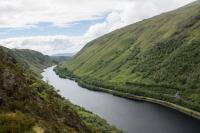
Ewan Crawford 21/06/2019
A series of 17 stone signals over a length of 3.2 miles are controlled by a rock screen uphill from the railway. The hillside above, the lower slope of Ben Cruachan, is sheer and rockfalls are not uncommon. The hillside drops to Loch Awe to the south. The portion of protected railway is on the north bank of loch and includes Falls of Cruachan station and the site of the former [[Awe ...
More details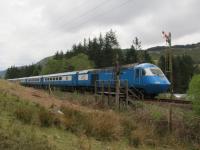
Malcolm Chattwood 02/05/2022
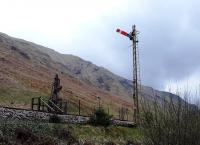
Malcolm Chattwood 07/04/2019
This was a siding with a loading bank. It was on the north side of the line and approached from the east. Nearby Cruinache was to the south of the line.
...
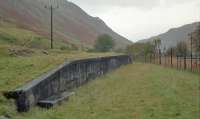
Ewan Crawford //1991
This is a high single track three span girder viaduct over the River Awe. The piers are masonry. The viaduct was completed in 1879 by W & T Adams.
...
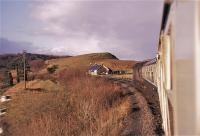
Robin McGregor 04/12/1970
Half a mile east of Taynuilt station this single track girder viaduct crosses the River Nant. It was completed in 1879 by W & T Adams.
...
This is a two platform station which still has its 1921 signal box, although out of use. There is a small car park. The station has a passing loop and sidings. It opened on the 1880 extension of the Callander and Oban Railway from Dalmally to Oban.
...
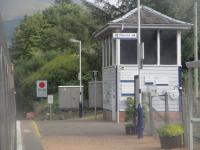
David Bosher 14/09/2022
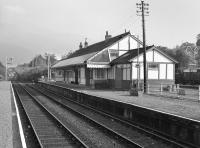
...
Bill Roberton //1984
This was a single platform station with a station building. The building was a smaller style C&O building. The platform was on the north side of the line.
...
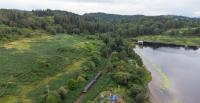
Ewan Crawford 24/08/2022
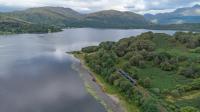
Ewan Crawford 24/08/2022
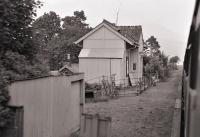
Brian Haslehust 11/08/1965
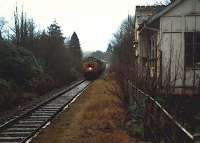
Ewan Crawford //1988
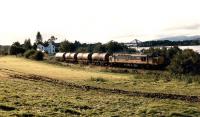
Ewan Crawford //1989
This is a single platform station with a shelter. There is a car park on the north side of the station. At the east end of the station is a goods loop and oil siding (both out of use). The station was once far larger and a junction.
...
See also
Ballachulish Branch (Callander and Oban Railway)
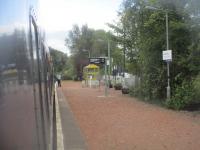
David Bosher 14/09/2022

Brian Haslehust 03/09/1964
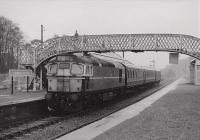
Brian Haslehust 26/03/1966
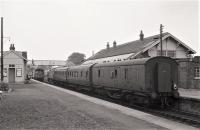
Brian Haslehust 11/08/1965
This was an extensive set of Wartime sidings laid out at Connel Ferry station in 1940 for the Admiralty. The sidings ran south east from the west end of the station, making a trailing connection by the west box.
...
This crossing was opened to break the single track section between Oban and Connel Ferry at Glencruitten Summit.
...
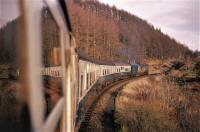
Robin McGregor 04/12/1970
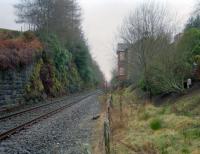
Ewan Crawford 04/01/2001
Oban Goods Junction was south of Oban station and provided access to Oban's principal goods yard, Lochavullin Goods, and locomotive shed Oban Shed. Both opened with the Oban extension in 1880.
...
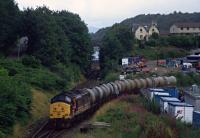
Ewan Crawford Collection //
This two road shed was south of Oban station and accessed from the junction for the Lochavullin Goods at Oban Goods Junction. Access to the goods yard was from the south and a reversal was necessary to reach the shed.
...
A closed goods yard south of the passenger terminus in Oban. The location is also known as Oban Goods or Oban High Level Goods. There were a number of sidings here and the Oban Shed, of which the turntable pit remains. An oil siding remained in use here until the early 1990s.
...
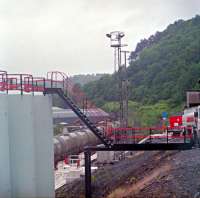
Ewan Crawford //1990
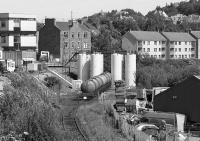
Bill Roberton 05/07/1991
This ticket platform was on the west side of the line, the arrival line for Oban station, on the short double track section between Oban Goods Junction and Oban. It was a stone built platform with the signal box for the goods junction located at its southern end. The railway continued in a deep rock cutting north to drop down to Oban station and pier.
...
This is a terminus at a ferry pier on Oban Bay. Oban is a major port for the islands with Caledonian MacBrayne operating services to Mull, Lismore and beyond.
...
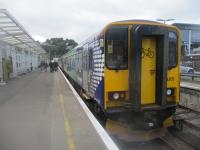
David Bosher 14/09/2022
This pier is located in the south of Oban Bay, a large natural anchorage protected from the west by the island of Kerrera. It was opened in 1880 along with Oban station by the Callander and Oban Railway. With the opening of the extension from Dalmally and the pier the railway was able to connect with ferry services to the West Coast of Scotland and the fishing fleet. The opening ...
More detailsSee also
Piers, Slips and Staiths

David Pesterfield 23/06/2006
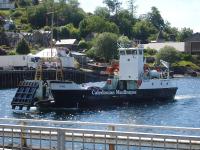
David Pesterfield 17/06/2013
Books










